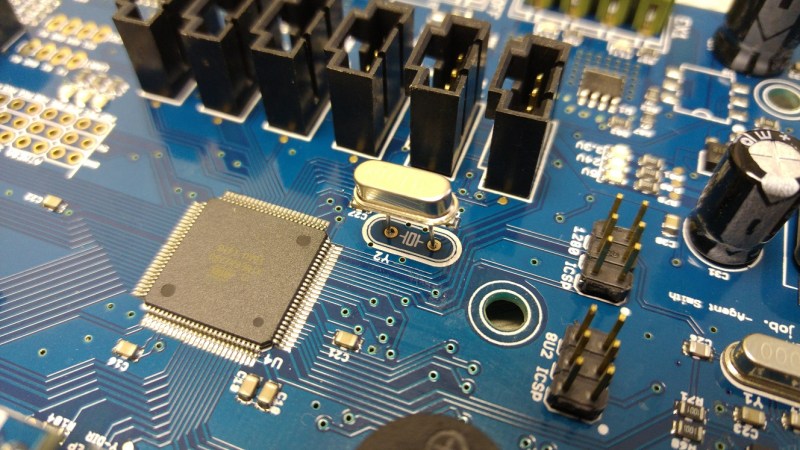It can be argued that MakerBot, a company that makes popular 3D printers, hit its pinnacle with the introduction of the Replicator 2. It was designed well and completely open source, including the motherboard that drove the printer – known as the Mightyboard. China quickly picked up on the success of the Replicator 2 and copy/pasted several of their own versions (at a much cheaper sale price). One of these outfits is called Wanhao, and their version of the Replicator 2 is called..wait for it…the Duplicator!
Their version of the Mighyboard is identical to the original, minus a few nickle and dime components. This suggests that Wanhao made an effort to cut as much cost as possible without looking at what functionality they were removing. And anytime a company does this, you can bet the quality of the board manufacturer is at the bottom of the barrel. [Avrydev] found this out the hard way when he repaired a faulty motherboard from a broken Duplicator.
The board would not connect to the software via USB, and the startup tune pitch was off. [Arvydev] flashed new firmware via ICSP, but that did not help. He eventually clued in on the main crystal for the Atmega processor. A quick swap and presto! The printer is as good as new.















“(..) the Replicator 2. It was designed well and completely open source (..)”
Actually, no. The firmware was still Open at release (or really, a little while afterwards), but the hardware and electronics were never publicly released.
You are thinking of the first generation Replicator, of similar design but plywood construction.
Source: Was part of MakerBot at the time, worked on design and testing of both.
Not really seeing how this is worthy for an article…
Well, not only it is a hack, but also really useful information for those having some broken Chinese electronics at hand.
Someday someone will thank this article
Agree, I’ll say Thanks already. Have a few of these “Duplicators”, have not had any problems but now I know one thing to check for if/when problems do arise.
thanks they help me
You get what you pay for. Keep in mind, while you are vilifying China for making cheap knock-offs that undercut and bury legitimate manufacturers, that the latter wouldn’t do it if people were not willing to buy their crap. The Chinese may be guilty when they do this, but every buyer is complicit as well
That’s human nature. If you were stranded in the desert and thirsty, and say you happen across two bodies of water, which one do you drink from? The one with clean water filled with crocodiles or the seemingly clean pond that’s free of any obvious danger. We drink the water that isn’t entirely clean because it’s easier to access. There’s less obvious cost.
Oh I know why people buy cheap items, it’s the complaining afterward, when it fails to meet expectations, that it’s the manufacturer’s fault alone that I think is idiotic.
The Chinese are guilty of nothing at all. They make and sell things. You have no choice other than to buy from the Chinese or pay 10 times the price and buy from someone that buys from the Chinese, they are one of the world’s few manufacturers now.
I don’t think anyone was being vilified here, I think most people appreciate that of you buy cheap from China you’re more than likely not going to get the same quality of electronics.
I also think there are quite a few people that wouldn’t mind the Chinese running MakerBot into the ground.
This one example shows a benefit and a detriment of open source.
You have people making crap, but if you know what you are doing you can diagnose the problem and upgrade the component. Try to do that with closed source crap.
+ to repairs. It’s so easy to repair boards when you can take a look at the schematic, corresponding board files for component placement, as well as firmware.
As if people didn’t make knockoffs of closed source stuff. Good luck fixing that.
Help please!
There is a knockoff of the FormLabs Form1+ SLA 3d printer from CTC (Same operation as as WanHao) and it is called the CTC Riverside. The motherboard is a staright rip from the Formlabs Form1+ but they run a home grown CTC Riverside firmware. Unfortunately their CTC Riverside firmware (version 1.1 as of 2/14/2016) is terrible and almost non-functional to the point that it borderlines on useless.
Is there anyone that can explain how to JTAG the Riverside (Form1+ clone) and replace the firmware with something functional?
I had the EXACT fault on an Arduino Uno R3. Changed out the 12 MHz xtal and it verks!
I suspect that it was defective from the start but how many other people would just give up and chuck it?
Apologies, 16 MHz. I’ve seen that fault before on pendrives and more recently clocks. Is it lead free solder demolishing the silvering inside the crystal casing maybe?
or its hand a wee bump. USB flash drives often fail due to a knackered crystal
Simple stated: no. If lead free solder could have that effect the crystal would already be faulty anyway.
It was possibly a marginal part that failed after testing, manufactured without testing or perhaps one of the clones on the market – never intended to work.
Dude, thank you for your post. I was having the same problems as you. now I can finish my work. – nanner